‘Behemoth’ is a word which springs to mind or, perhaps more nautically, ‘leviathan’.

If you are expecting the Axopar 28 to look like a traditional 8.5m powerboat, you’re in for a surprise. And if you’re expecting it to perform like one, you’re in for a shock.
Axopar is a Finnish manufacturer which produced its first boats only three years ago, but has been turning heads and winning awards in Europe ever since. The Axopar 28 was its first offering, but it has since released the 37 (11m) and 24 (7m) variants. More than 500 boats have been built, with the same number again constructed this year alone, making Axopar one of Europe’s fastest-growing boat brands.

Dominic Lowe, of New Zealand agent Windcraft, says demand for the boats has gone “absolutely berserk” since last season’s European boat shows.
“Both the 28 and 37 were named ‘boat of the year’ at shows in Europe, and since then the order books have just gone nuts. For us to get into the production queue we have to pre-order a long way in advance, but they are increasing capacity at the factory.”
Lowe says the Australian market has received the new design enthusiastically – around 40 boats are there now – and the first two boats have been sold here. The 28 is available in three configurations here: with an enclosed central cabin and aft cabin (as seen here), an open model which seats up to eight, and the “T-Top” with no cabin, a canvas top, and a double berth aft.
So what at makes the Axopar such a hot ticket? Well, the first thing you notice is that it doesn’t look like any other 8.5m powerboat. Older Kiwis, raised on a diet of Sea Nymphs and Haines Hunters, might find themselves scratching their heads. Its low freeboard, open bow and multi-straked hull certainly look … well, different.
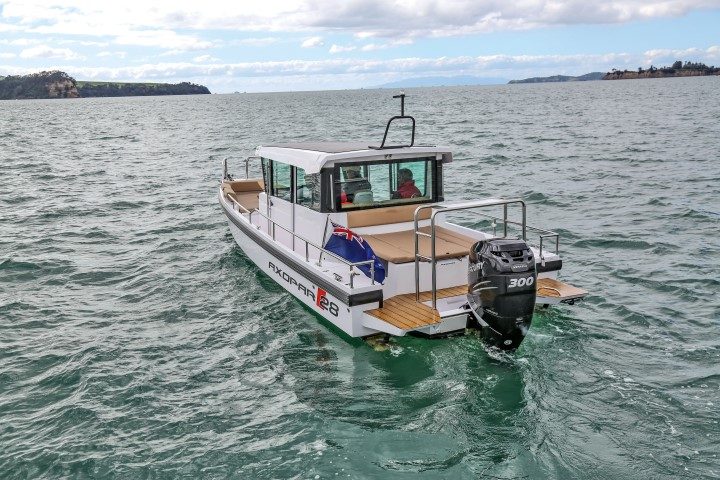
Lowe laughs. “A lot of people have been quite shocked by how radical it looks. The first thing everybody says is, ‘The bow is so low – it must be a really wet boat’, but it’s far from wet.”
The hull shape is the real attention-grabber: a slightly snub bow at deck level with a deep, 22o vee below, then a large chine mid-topsides, with smaller strakes below it. And what you can’t see, below the water, are the two ‘steps’ further aft, transitioning the hull shape to a much flatter section. This hull shape is designed to produce a smooth, dry, level ride at high speeds, even in choppy seas, as well as controlled turning.
“At any given speed you are using a number of the steps, rather than just having a single planing hull form, which also makes it more comfortable at displacement speeds,” says Lowe.
“It slips onto the plane earlier, too, at just over 12 knots, and there’s a very smooth transition. When you’re on the plane, not a lot of the boat is in the water, and it has such a fine entry that she just slices right through it.
“It’s quite a different market to other powerboats,” Lowe says. “It’s for people who might be time-poor, who want to get out there and enjoy being on the water. You can go for a fish, socialise with friends, or boost out to Waiheke or Great Barrier.”
Owner Kerry Knight says he was looking for a small, practical day-boat that could be used for overnighting if need be. Knight uses it for day-tripping and fishing with his wife and friends, as well as a fast, comfortable way of getting to his property on Kawau (the 30-mile trip takes around an hour from Auckland – and less in flat conditions).
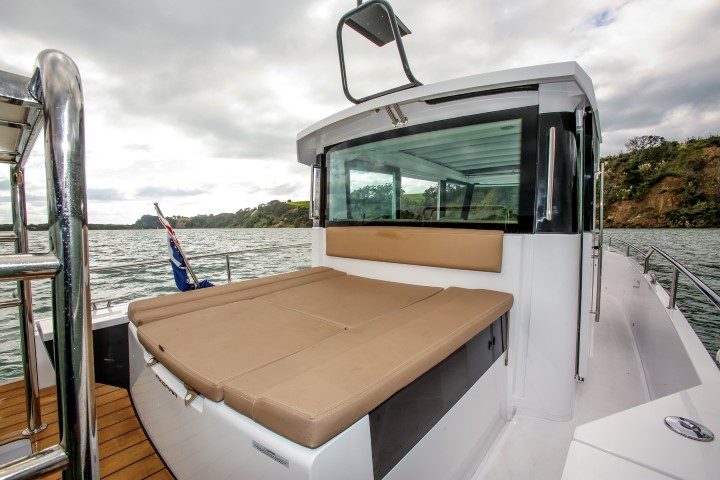
“The weather up in Kawau Bay can be incredibly rough, but you just close the cabin doors — you feel so enclosed – and just cut through the waves. It rides really well.”
ON BOARD
Stepping easily from the dock onto the walkaround side-decks, the cabin is entered through large sliding doors (one each side). The cabin is glazed right around, making for great visibility for skipper and passengers.
With its high, comfortable fabric-covered seats, it looks and feels more like the interior of a high-end SUV than a powerboat. Everyone faces forward and the seating is elevated and comfortable.
The matte-finish black dash is simple: again, SUV style, with a Raymarine chartplotter in front of the racing-car-style steering wheel and throttle and trim-tab controls to starboard. There’s also the display for Mercury’s SmartCraft engine monitoring system, which shows speed, efficiency and fuel remaining, and space to mount an iPad to use as a secondary display.
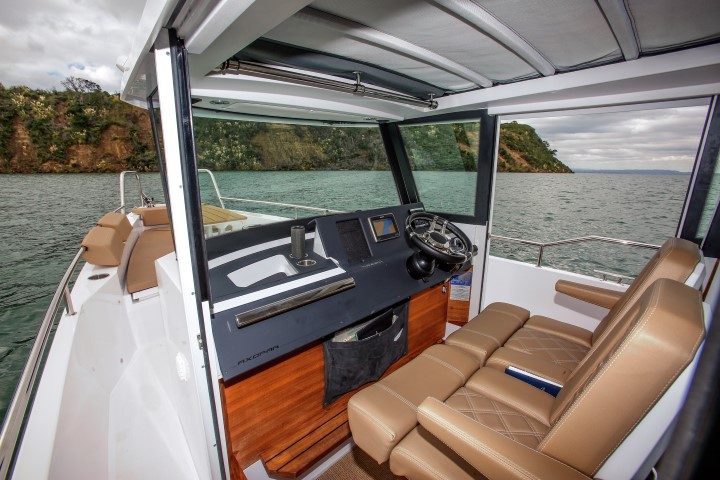
So far so good. But where’s the galley, the head, the berths? Here’s where the clever design kicks in.
The front seats swivel to face aft, and a drop-leaf dining table can be fitted so four can dine comfortably. These seats also tip up to reveal space where a cooker and chiller can be fitted.
The two rear seats can either be folded out horizontally to create two berths, or lifted up out of the way (or removed entirely) to provide access to the surprisingly roomy double cabin under the aft deck. This has a light and airy feel, with windows at the sides and a large hatch on top. Above the main cabin is a concertina canvas roof.
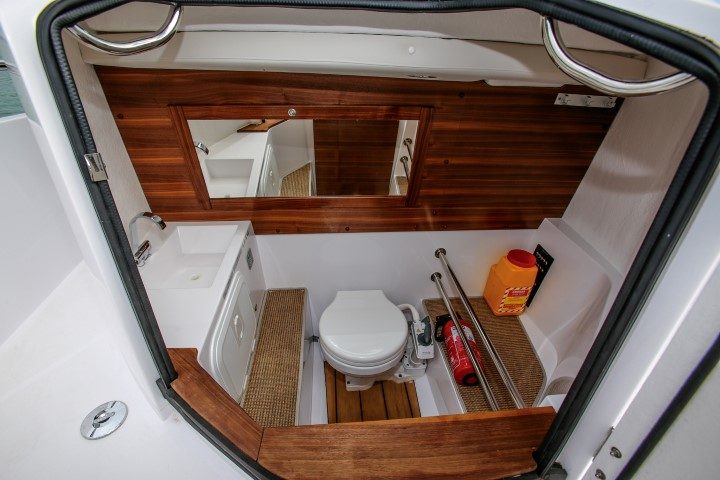
The head is tucked away, Tardis-like, at the front of the cabin, accessed from the foredeck, with a sink and storage space adjacent. There is also a large seating area up on the foredeck, with nifty back cushions which can be slid along the handrail to wherever they are required.
The angular table folds down to create a daybed. Right at the bow is the anchor fairlead and winch controls, plus a storage locker. Knight says this offset anchor makes it easy to nose the boat right into the beach and hop straight off.

On the aft deck – there is no “cockpit” as such – there is a seating area on top of the aft cabin, with room to walk around it. There is a small boarding platform either side of the giant outboard, with a fold-down boarding ladder on one side.
There are a couple of large, draining wet-lockers here, and on the model we tested the owner has custom-fitted a frame for his bait-board and barbecue. Knight says this aft space is excellent for fishing. “Six people can be fishing around it without getting tangled up.”
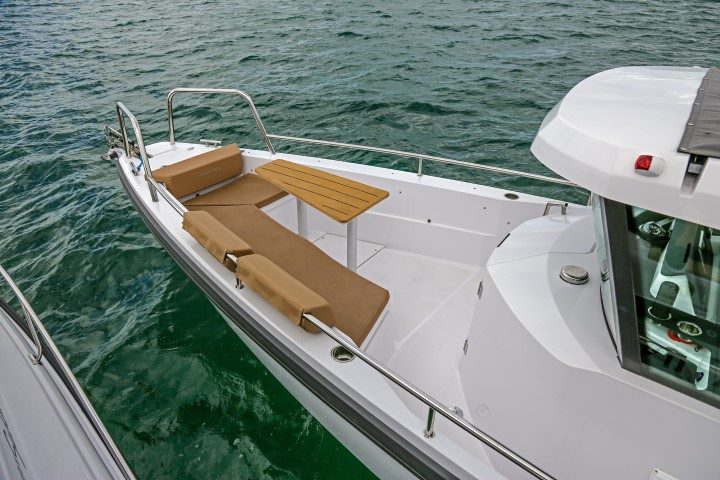
The high level of finish throughout is notable. White GRP is complemented by Flexiteek decking, with substantial stainless steel railing right around.
Providing the power is a big, black 300hp four-stroke Mercury Verado – a step up from the standard 200hp model, but you can specify up to 350hp. You can customise the propeller set-up, too.
There’s a 260-litre fuel tank, and you can keep an eye on the engine’s fuel usage and level through the SmartCraft system, and optimise the boat’s performance for the conditions.
ON THE WATER
Leaving the inner harbour, Lowe opens up once past North Head and are immediately skimming along at around 37 knots. The ride is extremely smooth, and we perch on the back seats as if we’re being chauffeur-driven in a Range Rover. Cornering at 30 knots plus is a breeze, even when crossing our own wake, and Lowe enjoys pulling a few donuts for the camera boat.
Lowe is disappointed we can’t find a few more big waves to speed through – conditions remain stubbornly benign for our test. The best we can do is the Quickcat wake, which the Axopar makes short work of, with no slamming at all.
As we blast into Islington Bay, I sit up at the bow. Despite zooming along at 30 knots, the ride is completely flat, smooth and dry – no spray finds its way onto the deck at all. It’s a strange sensation, like flying along on the head of an arrow.
On the way back to base, Boating sales director Brett Patterson takes the helm and pushes her up to a top speed of 43 knots, leaving the camera boat for dust (and he reckons a few more knots could definitely be achieved in the right conditions).
The Axopar cruises effortlessly at 30 knots, eating up the head seas with no sign of spray over the deck. The handling is agile and precise, especially in tight turns, and there is no discernible hump when transitioning from displacement to planing speeds. Did he enjoy his drive? Let’s just say I had some concerns about being able to prise him from the steering wheel.
The Axopar 28 is certainly different in a world full of cookie-cutter powerboats. It might not be to everyone’s taste aesthetically, but it’s hard to argue with a flat, dry ride at 30 – 50 knots, arriving at your destination with all internal organs in place. The use of interior space is also clever and innovative. Watch this space for how the brand takes off in New Zealand.
‘Behemoth’ is a word which springs to mind or, perhaps more nautically, ‘leviathan’.
White Pointer has earned the respect of discerning customers in New Zealand and Australia, attracting a loyal and ever growing following for its high-quality, rugged and totally dependable aluminium trailer boats.
The hardtop SP635 shares the same underpinnings as the popular SF 635 which was a completely new model back in 2020.
The pride and joy of a multi-generational family, Bliss resides on a pier that’s home to a couple of other Elite motor launches – Sandspit Marina is a hot-spot for the Bill Upfold-designed vessels, with several calling this small marina home.